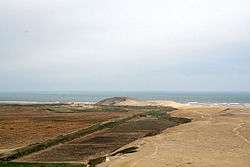Huaca Prieta
|
Panoramic view of Huaca Prieta | |
 Location in Peru | |
| Location | La Libertad Province, Peru |
|---|---|
| Region | Chicama Valley |
| Type | settlement |
| History | |
| Founded | ca. 14,500 BP[1] |
| Abandoned | ca. 4000 BP[1] |
| Cultures | El Brujo Archaeological Complex |
| Site notes | |
| Archaeologists | Junius B. Bird |
Huaca Prieta is the site of a prehistoric settlement beside the Pacific Ocean in the Chicama Valley , just north of Trujillo, La Libertad Province, Peru. It is a part of the El Brujo Archaeological Complex, which also includes Moche (culture) sites.
Huaca Prieta was occupied as early as 4700 BC, before the ceramics were introduced. It consisted of a huge mound of ash, stones, textiles, plants and shells, with some burials and constructions.
Excavations
It was first excavated by Junius B. Bird in 1946–1947 who excavated three large test pits in or beside it. The remains, now at the American Museum of Natural History in New York City, include many examples of complex textiles made with twining techniques which incorporated intricate designs of mythological humans, condors, snakes and crabs. The many stone artifacts were not fancy—fish net weights, flakes and simple pebble tools; there were no projectile points.[2][3] In the upper part of the mound there were many underground structures of unknown function, some with burials. They were made of cobblestones cemented with an ash-water mixture. The inhabitants fished, gathered shellfish, and grew fruit, gourds, squash, peppers, beans, tubers and, importantly, cotton.[4]
There is a low mound 70–170 m to the north (now called Monticulo Cupisnique) where Bird excavated three test pits. He found many ruins and much refuse, including ceramics of the Guañape, Early Cupisnique and Cupisnique cultures. The last is linked to the highland Chavín culture. A large tsunami damaged both mounds leaving a thick layer of cobblestones just north of the preceramic mound, at about 850 BCE, between the two Cupisnique phases.
Early maize found
Until recently, it was beilieved that maize was introduced to the region rather late, after the tsunami.
In 2012, it was reported that corncobs found at two ancient sites in Peru (Paredones and Huaca Prieta) may date from as early as 4700 B.C. This suggests that people living along the coast of northern Peru were already eating corn by that time.[5][6][7]
These results were reported by Dolores Piperno, and other scientists from Washington's National Museum of Natural History This is the earliest maize discovered so far in South America.
Early use of indigo dye
In 2016, 6000-year-old dyed cotton fabric was discovered at the Preceramic site of Huaca Prieta. Analysis of the pigment identified it as indigotin, an indigoid dye. This marks the earliest recorded use of indigo dye to date, predating the use of indigo in Egypt's Fifth Dynasty by about 1,500 years.[1]
| Wikimedia Commons has media related to Huaca Prieta. |
See also
References
- 1 2 3 Splitstoser, Jeffrey C.; Dillehay, Tom D.; Wouters, Jan; Claro, Ana (September 2016). "Early pre-Hispanic use of indigo blue in Peru". Science Advances. doi:10.1126/sciadv.1501623.
- ↑ Junius B. Bird, John Hyslop and Milica Dimitrijevic Skinner (1985). The Preceramic Excavations at the Huaca Prieta, Chicama Valley, Peru. Anthropological Papers of the American Museum of Natural History. 62. American Museum of Natural History. ISSN 0065-9452.
- ↑ Sigfried J. de Laet, Ahmad Hasan Dani, eds. (1996). History of Humanity: From the third millennium to the seventh century B.C. History of Humanity: Scientific and Cultural Development. 2. UNESCO. p. 1100. ISBN 92-3-102811-1.
- ↑ Clark, Grahame (1977). World prehistory in new perspective (3rd ed.). Cambridge University Press. pp. 432–433. ISBN 0-521-29178-X.
- ↑ "Popcorn Was Popular in Ancient Peru, Discovery Suggests". History.com. 20 January 2012.
- ↑ "Study suggests ancient Peruvians 'ate popcorn'". BBC News. 19 January 2012. Retrieved 26 January 2012.
- ↑ Grobman, A.; Bonavia, D.; Dillehay, T. D.; Piperno, D. R.; Iriarte, J.; Holst, I. (2012). "Preceramic maize from Paredones and Huaca Prieta, Peru". Proceedings of the National Academy of Sciences. 109 (5): 1755. doi:10.1073/pnas.1120270109.
External links
- K. Kris Hirst, Huaca Prieta (Peru): Formative Mound Construction in Peru archaeology.about.com
Coordinates: 7°55′26″S 79°18′25″W / 7.924°S 79.307°W
